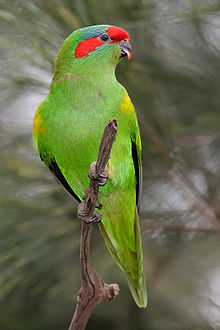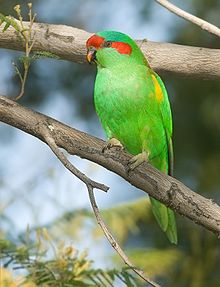- Musk Lorikeet
-
Musk Lorikeet 
Conservation status Scientific classification Kingdom: Animalia Phylum: Chordata Class: Aves Order: Psittaciformes Family: Psittacidae Tribe: Lorini Genus: Glossopsitta Species: G. concinna Binomial name Glossopsitta concinna
(Shaw, 1791)The Musk Lorikeet (Glossopsitta concinna) is a lorikeet, one of the three species of the Glossopsitta genus.[1] It inhabits south-central/eastern Australia. The Musk Lorikeet was first described by ornithologist George Shaw in 1790 as Psittacus concinnus, from a collection in the vicinity of Port Jackson in what is now Sydney. John Latham described it as Psittacus australis. Its specific epithet is the Latin concinna "elegant".[2] Other common names include Red-eared Lorikeet, and Green Keet,[3] and formerly a local Sydney indigenous term Coolich.[4] The names Green Leek and King Parrot have been incorrectly applied to this species in the past.[3]
Contents
Description
The Musk Lorikeet is 22 cm (8.5 in) long. It is mainly green and it is identified by its red forehead, blue crown and a distinctive yellow band on its wing. Both upper and lower mandibles of the beak are red at the tip and darker near its base. The blue area on the crown of the female is smaller and paler than seen on the male.
Distribution and habitat
Musk Lorikeets are found in eastern New South Wales, Victoria, South Australia and Tasmania.[5] Range: Uncommon nomad in woodlands and drier forests in south-east mainland, mainly west of divide, and TAS.
Breeding
The musk lorikeet breeds mainly from August to January. Their nest are usually built in a hollow limb of a tree. Two white 25 × 20 mm (0.98 × 0.79 in) eggs are laid.[citation needed]
References
- ^ "Zoological Nomenclature Resource: Psittaciformes (Version 9.004)". www.zoonomen.net. 2008-07-05. http://www.zoonomen.net/avtax/psit.html.
- ^ Simpson DP (1979). Cassell's Latin Dictionary (5 ed.). London: Cassell Ltd.. p. 883. ISBN 0-304-52257-0.
- ^ a b Lendon, p. 23
- ^ Long, George (1841). The Penny Cyclopædia of the Society for the Diffusion of Useful Knowledge. London: Charles Knight & Co.. p. 90.
- ^ "Musk Lorikeet". Australian Museum - Birds in Backyards. http://www.birdsinbackyards.net/finder/display.cfm?id=361. Retrieved 2009-08-22.
- BirdLife International (2008). Glossopsitta concinna. In: IUCN 2008. IUCN Red List of Threatened Species. Downloaded on 14 April 2008.
Cited texts
- Lendon, Alan H. (1973). Australian Parrots in Field and Aviary (2nd. ed). Sydney: Angus and Robertson. ISBN 0-207-12424-8.
- Low, Rosemary (1978). Lories and Lorikeets. Melbourne: Inkata Press. ISBN 0-909605-08-4.
Lories and lorikeets (Tribe: Lorini) Genus Species (taxonomy note: * indicates taxa that may classified as a subspecies of the Rainbow Lorikeet or a separate species)
(extinctions: † indicates a species confirmed to be extinct, ₴ indicates evidence only from sub-fossils)Chalcopsitta Eos Pseudeos Trichoglossus Ornate Lorikeet • Pohnpei Lorikeet • Mindanao Lorikeet (or Johnstone's Lorikeet) • Citrine Lorikeet (or Yellow-and-green Lorikeet) • Rainbow Lorikeet • Sunset Lorikeet (or Scarlet-breasted Lorikeet) * • Leaf Lorikeet (also Flores Lorikeet or Weber's Lorikeet) * • Marigold Lorikeet * • Red-collared Lorikeet * • Scaly-breasted Lorikeet • Olive-headed LorikeetPsitteuteles Lorius Phigys Vini Blue-crowned Lorikeet • Kuhl's Lorikeet (or Rimatara Lorikeet) • Stephen's Lorikeet (or Henderson Lorikeet) • Violet Lorikeet (Blue Lorikeet or Tahitian Lory) • Ultramarine Lorikeet • Sinoto's Lorikeet † ₴ • Conquered Lorikeet † ₴Glossopsitta Charmosyna Oreopsittacus Neopsittacus 
This article relating to parrots is a stub. You can help Wikipedia by expanding it.


